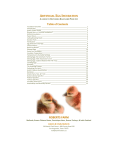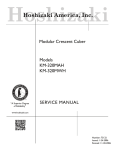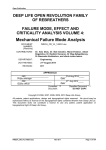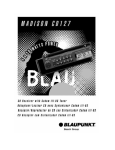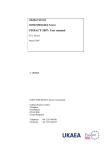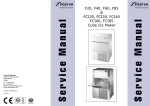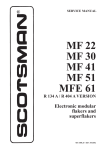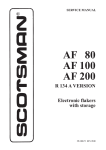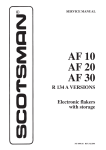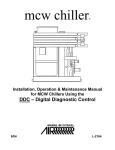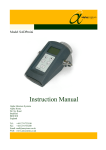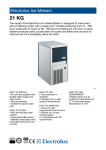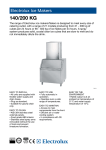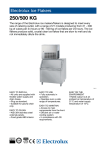Download Service manual: FMIF 220 and FMIF 550 electronic modular flakers
Transcript
Back to top Service manual for the FMIF 220 and FMIF 550 electronic modular flakers UK trade spare parts and servicing Menu Service manual FMIF 220 and FMIF 550 electronic modular flakers Copyright Copyright Foster Refrigerator (UK) Limited, November 2000 All rights reserved. No part of this publication may be reproduced, stored in a retrieval system, or transmitted in any form or by any means, electronic, mechanical, photocopying, recording or otherwise, without the prior permission of Foster Refrigerator (UK) Limited. Foster Refrigerator (UK) Limited Oldmedow Road KING'S LYNN PE30 4JU United Kingdom Tel: +44 (0) 1553 691122 Fax: +44 (0) 1553 691447 Web: www.fosterrefrigerator.co.uk November 2000 Page ii Menu Service manual FMIF 220 and FMIF 550 electronic modular flakers Safety of personnel Liability Foster Refrigerator (UK) Limited decline responsibility when an attempt is made to use the refrigerator for any purpose other than that for which it was designed. WARNING! THOSE WHO MAINTAIN THE REFRIGERATOR MUST BE TRAINED IN STANDARD REPAIR AND MAINTENANCE PRACTICES AND MUST HAVE READ AND UNDERSTOOD THE SAFETY INSTRUCTIONS CONTAINED IN THIS MANUAL BEFORE CARRYING OUT ANY MAINTENANCE. Operating environment Temperature The Refrigerator must be used in a clean, well-lit environment with a stable temperature of approximately 5°C to 35°C. Relative humidity The Refrigerator must be used in an environment with a relative humidity between 20% to 80% (non-condensing). Symbols and decals Personnel must be familiar with all the warning symbols and decals fitted to the Refrigerator. Failure to recognise a warning and read the associated safety instructions may result in injury or death. THIS DECAL IS USED TO INDICATE AN ELECTRICAL HAZARD. THE REFRIGERATOR MUST BE DISCONNECTED FROM THE MAINS ELECTRICAL POWER SUPPLY WHEN THIS DECAL IS ENCOUNTERED DURING INSTALLATION AND MAINTENANCE. Electrical hazard WARNING! THE REFRIGERATOR MUST BE DISCONNECTED FROM THE MAINS ELECTRICAL POWER SUPPLY WHEN THIS DECAL IS ENCOUNTERED DURING INSTALLATION, MAINTENANCE OR SETTING-UP. November 2000 Page iii Menu Service manual FMIF 220 and FMIF 550 electronic modular flakers Electro-static discharge (ESD) CAUTION! Precautions against ESD must be taken to prevent damage to the Refrigerator control circuits: (1) Ensure that the operating environment is protected against ESD. (2) Do not touch electronic circuits or wafers. (3) Always use a grounded wrist strap while handling electronic circuits. November 2000 Page iv Menu Service manual FMIF 220 and FMIF 550 electronic modular flakers 1. Specifications 1.1 Modular flaker model FMIF 220 electronic Important operating requirements: Air temperature Water temperature Water pressure Electr. voltage variations from voltage rating specified on nameplate 1.2 Min. Max. 10°C (50°F) 5°C (40°F) 1 bar -10% 40°C (100°F) 40°C (100°F) 5 bar +6% Ice making capacity November 2000 Page 1 Menu Service manual FMIF 220 and FMIF 550 electronic modular flakers NOTE — The daily ice-making capacity is directly related to the condenser air inlet temperature, water temperature and age of the machine. To keep your FLAKER at peak performance levels, periodic maintenance checks must be carried out as indicated on page 46 of this manual. November 2000 Page 2 Menu Service manual FMIF 220 and FMIF 550 electronic modular flakers FMIF 220 machine specifications Model Cond. unit Finish Comp. HP Water reg. It/24hr FMIF 220 AS Air S. Steel 1/2 200 FMIF 220 WS Water S. Steel 1/2 850* Gas Charge Standard Supply R22 480 grams 220/50/1 R22 R404A 880 grams 220/50/1 R404A Start Amps Run Amps Watts Fuse Rating 15.8 3.4 670 10 Amp 20 4 760 10 Amp * At 15°C water temperature. November 2000 Page 3 Menu Service manual FMIF 220 and FMIF 550 electronic modular flakers 2. Specifications 2.1 Electronic modular superflaker model FMIF 550 Important operating requirements: Air temperature Water temperature Water pressure Electr. voltage variations from voltage rating specified on nameplate 2.2 Min. Max. 10°C (50°F) 5°C (40°F) 1 bar -10% 40°C (100°F) 40°C (100°F) 5 bar +6% Ice making capacity November 2000 Page 4 Menu Service manual FMIF 220 and FMIF 550 electronic modular flakers NOTE — The daily ice-making capacity is directly related to the condenser air inlet temperature, water temperature and age of the machine. To keep your FLAKER at peak performance levels, periodic maintenance checks must be carried out as indicated on page 46 of this manual. November 2000 Page 5 Menu Service manual FMIF 220 and FMIF 550 electronic modular flakers FMIF 220 machine specifications Model Cond. unit Finish Comp. HP Water reg. It/24hr FMIF 220 AS Air FMIF 220 WS Water Gas Charge Standard Supply R22 480 grams 220/50/1 R22 R404A 880 grams 220/50/1 R404A S. Steel 1/2 200 850* Start Amps Run Amps Watts Fuse Rating 15.8 3.4 670 10 Amp 20 4 760 10 Amp * At 15°C water temperature. November 2000 Page 6 Menu Service manual FMIF 220 and FMIF 550 electronic modular flakers 3. General information and installation 3.1 Introduction This manual provides the specifications and the step-by-step procedures for the installation, start up and operation, maintenance and cleaning for the Modular Ice makers. The Electronic Flakers are quality designed, engineered and manufactured. Their ice making systems are thoroughly tested providing the utmost in flexibility to fit the needs of a particular user. This product qualifies for the following listings: These ice makers have been engineered to our own rigid safety and performance standards. The VDE-SEV-WRC seals signify that it is listed with them and that it complies with the materials and manufacturing standards of them. These seals also signify that these ice maker models have been inspected and tested by VDE-SEV-WRC inspectors who reserve the right to periodically examine production ice makers at the factory to assure continued compliance. NOTE — To retain the safety and performance built into this ice maker, it is important that installation and maintenence be conducted in the manner outlined in this manual. 3.2 Unpacking and inspection Ice maker 1. Call your authorised Distributor or Dealer for proper installation. 2. Visually inspect the exterior of the packing and skid. Any severe damage noted should be reported to the delivering carrier and a concealed damage claim form filled in subject to inspection of the contents with the carrier's representative present. 3. November 2000 a. Cut and remove the plastic strip securing the carton box to the skid. b. Remove the packing nails securing the carton box to the skid. c. Cut open the top of the carton and remove the polystyrene protection sheet. d. Pull out the polystyrene posts from the corners and then remove the carton. 4. Remove the front and side panels of the unit and inspect for any concealed damage. Notify carrier of your claim for the concealed damage as stated in step 2 above. 5. Remove all internal support packing and masking tape. 6. Check that refrigerant lines do not rub against or touch other lines or surfaces, and that the fan blades move freely. Page 7 Menu Service manual FMIF 220 and FMIF 550 electronic modular flakers 7. Check that the compressor fits snugly onto all its mounting pads. 8. See data plate on the rear side of the unit and check that local main voltage corresponds with the voltage specified on it. CAUTION — Incorrect voltage supplied to the icemaker will void your parts replacement programme. 3.3 Location and levelling CAUTION — This Modular Flaker is designed for indoor installation only. Extended periods of operation at temperatures exceeding the following limitations will constitute misuse under the terms of the FOSTER Manufacturer's Limited Warranty resulting in LOSS of warranty coverage. 1. 2. 3.4 Position the storage bin in the selected permanent location. Criteria for selection of location include: a. Minimum room temperature temperature 40°C (100°F). 10°C (50°F) and maximum room b. Water inlet temperatures: minimum 5°C (40°F) and maximum 40°C (100°F). c. Well ventilated location for air cooled models (clean the air cooled condenser at frequent intervals). d. Service access: adequate space must be left for all service connections through the rear of the ice maker. A minimum clearance of 15cm (6in) must be left at the sides of the unit for routing cooling air drawn into and exhausted out of the compartment to maintain proper condensing operation of air cooled models. Level the Storage Bin Assy in both the left to right and front to rear directions by means of the adjustable legs. Electrical connections See data plate for current requirements to determine wire size to be used for electrical connections. All Foster ice makers require a solid earth wire. All Foster ice machines are supplied from the factory completely pre-wired and require only electrical power connections to the wire cord provided at rear of the unit. Make sure that the ice machine is connected to its own circuit and individually fused (see data plate for fuse size). The maximum allowable voltage variation should not exceed -10% and +13% of the data plate rating. Low voltage can cause faulty functioning and may be responsible for serious damage to the overload switch and motor windings. NOTE — All external wiring should conform to national, state and local standards and regulations. Check voltage on the line and the ice maker's data plate before connecting the unit. November 2000 Page 8 Menu Service manual FMIF 220 and FMIF 550 electronic modular flakers 3.5 Water supply and drain connections General When choosing the water supply for the ice flaker consideration should be given to: • Length of run • Water clarity and purity • Adequate water supply pressure. Since water is the most important single ingredient in producing ice the three items listed above cannot be over emphasised. Low water pressure, below 1 bar may cause malfunction of the ice maker unit. Water containing excessive minerals will tend to produce scale build-up on the interior parts of the water system while too soft water (with too low contents of mineral salts), will produce a very hard flaker ice. Water supply Connect the 3/4in GAS male of the water inlet fitting, using a food grade flexible tubing or a 3/8in O.D. copper pipe, to the cold water supply line with regular plumbing fitting and a shut-oft valve installed in an accessible position between the water supply line and the unit. If water contains a high level of impurities, it is advisable to consider the installation of an appropriate water filter or conditioner. Water supply - Water cooled models The water cooled versions of Foster ice makers require two separate inlet water supplies, one for the water making the flaker ice and the other for the water cooled condenser. Connect the 3/4in GAS male fitting of the water inlet, using flexible tubing or a 3/8in O.D. copper pipe, to the cold water supply line with regular plumbing fitting and a shut-oft valve installed in an accessible position between the water supply line and the unit. Water drain The recommended drain tube is a plastic or flexible tube with 18mm (3/4in) I.D. runs to an open trapped and vented drain. When the drain is a long run, allow 3cm pitch per metre (1/4in pitch per foot). Install a vertical open vent on drain line high point at the unit drain connection to ensure good draining. The ideal drain receptacle is a trapped and vented floor drain. Water drain - Water cooled models Connect the 3/4in GAS male fitting of the condenser water drain, utilising a second flexible tubing or a 3/8in O.D. copper tubing, to the open trapped and vented drain. This additional drain line must not interconnect to any other of the unit's drains. NOTE — The water supply and the water drain must be installed to conform with the local code. In some cases a licensed plumber and/or a plumbing permit is required. November 2000 Page 9 Menu Service manual FMIF 220 and FMIF 550 electronic modular flakers 3.6 Final checklist 1. Is the unit in a room where ambient temperatures are within a minimum of 10°C (50°F) even in winter months? 2. Is there at least a 15cm (6in) clearance around the unit for proper air circulation? 3. Is the unit level? (IMPORTANT). 4. Have all the electrical and plumbing connections been made, and is the water supply shut-off valve open? 5. Has the voltage been tested and checked against the data plate rating? 6. Has the water supply pressure been checked to ensure a water pressure of at least 1 bar (14psi). 7. Have the bolts holding the compressor down been checked to ensure that the compressor is snugly fitted onto the mounting pads? 8. Check all refrigerant lines and conduit lines to guard against vibration and possible failure. 9. Have the bin liner and cabinet been wiped clean? 10. Has the owner/user been given the User Manual and been instructed on the importance of periodic maintenance checks? 11. Has the manufacturer's registration card been filled in properly? Check for correct model and serial number against the serial plate and mail the registration card to the factory. 12. Has the owner been given the name and the phone number of the authorised Foster Service Agency? November 2000 Page 10 Menu Service manual FMIF 220 and FMIF 550 electronic modular flakers 3.7 Installation practice CAUTION — This ice maker is not designed for outdoor Installation and will not function In ambient temperatures below 10°C (50°F) or above 40°C (100°F). This Ice maker will malfunction with water temperatures below 5°C (40°F) or above 40°C (100°F). November 2000 Page 11 Menu Service manual FMIF 220 and FMIF 550 electronic modular flakers 4. Operating instructions 4.1 Start-up After correctly installing the ice maker and completing the plumbing and electrical connections, perform the following 'Start-up' procedure: • Open the water supply line shut-off valve and put the unit under electrical power by moving the main switch, on the power supply line, to the ON position. The first LED - GREEN - will glow to signal that unit is under power. NOTE — Every time the unit is put under power, after being kept for some time in shut-off conditions (electrically disconnected) the RED LED, will blink for 3 minutes after which the unit will start up with the immediate operation of the gear motor assembly and, after 5 seconds, the compressor assy (Fig. 1). • • When 3 minutes have elapsed - stand-by period - the unit starts operating with sequential activation of the following assemblies: – GEAR MOTORS – COMPRESSOR – FAN MOTORS (if the unit air-cooled). These are controlled by the condenser temperature sensor which has its probe within the condenser fins (Fig. 2). After 2 or 3 minutes have elapsed from the compressor start-up, observe that flaker ice begins falling from the ice spout, through the ice chute, into the storage bin. NOTE — The first ice flakes which fall into the ice storage bin are not very hard as the evaporating temperature has not yet reached the correct operating value. It is necessary to allow the ice - just made - to cure, and wait approximately ten minutes for the evaporating temperature to reach the correct value thus making harder ice. November 2000 Page 12 Menu Service manual FMIF 220 and FMIF 550 electronic modular flakers November 2000 Page 13 Menu Service manual FMIF 220 and FMIF 550 electronic modular flakers November 2000 Page 14 Menu Service manual FMIF 220 and FMIF 550 electronic modular flakers NOTE — If, after ten minutes from the compressor start-up, the evaporating temperature has not dropped down to a value lower than -1°C (30°) (due to insufficient refrigerant in the system or excessive condensing temperature) the evaporating temperature sensor detects an abnormal condition and consequently stops the unit operation. If this occurs, the 5th warning YELLOW LED will blink (Fig. 3). After diagnosing and eliminating the cause the abnormal condition it is necessary to restart the unit by pushing the RE-SET BUTTON which protrudes through a hole in the control box cover. The unit, before resuming the total operation, will go through the usual 3 minutes STAND-BY period. 4.2 Operation checks on unit start-up 1. Remove front service panel and, if necessary, install the refrigerant service gauges on the corresponding Schrider valves to check both the HI and LO refrigerant pressures. NOTE — On air cooled models, the head (condensing) pressure is maintained between 13.5 and 14.5 bar (190-205psig). This is controlled according to the condenser temperature sensor, which is located within the condenser fins. In the event of the condenser becoming clogged - sufficiently to prevent the proper flow of the cooling air - or in the case of the fan motor being out of operation, the condenser temperature rises and when it reaches 70°C (160°F) for air-cooled versions and 62°C (145°F) - for water-cooled versions - the condenser temperature sensor shuts-off the ice maker and illuminates the RED WARNING LIGHT (Fig. 4). After diagnosing and eliminating the cause of the temperature rise is necessary to proceed as per the previous 'NOTE' to start-up again the operation of the ice maker. November 2000 Page 15 Menu Service manual FMIF 220 and FMIF 550 electronic modular flakers 2. Check for correct CUT-OUT and CUT-IN of the float reservoir water level sensors by first closing the water shut-off valve on the water supply line. This will cause a gradual decrease of the water level in the float reservoir and as soon as the level falls below the sensors, the flaker stops operating and the YELLOW warning LED glows to signal the shortage of water (Fig. 5). November 2000 Page 16 Menu Service manual FMIF 220 and FMIF 550 electronic modular flakers NOTE — The water level sensor detects the presence of sufficient water in the float reservoir and confirms it to the microprocessor by maintaining a low voltage current flow between the two sensors using the water as a conductor. CAUTION — The use of de-mineralised water (water with no salt content) having an electrical conductivity lower than 30µS, will reduce, or even eliminate the effectivity of the water sensors. Consequently, the microprocessor will shut off the unit and illuminate the YELLOW LED thus indicating shortage of water regardess of the actual water level in the reservoir After this open the water supply line shut-off valve to refill the float reservoir, the YELLOW LED goes off and the RED LED starts blinking. After 3 minutes the unit resumes its normal operation with the immediate start-up of the gear motor and, 5 seconds later, the compressor. 3. Check for the correct operation of the electronic eye (one per each ice chute on model MF61) for the ice bin level control, by placing one hand between the sensing 'eyes' located in the ice spout, to interrupt the light beam. This interruption will cause an immediate extinguishing of the RED LED located on the front of the P.C. Board and after about 10 seconds causes the shut-oft of the unit with the simultaneous lighting of the YELLOW LED signalling the full bin situation (Fig. 6). November 2000 Page 17 Menu Service manual FMIF 220 and FMIF 550 electronic modular flakers Allow the resumption of the light beam previously interrupted and after about 10 seconds the flaker will resume - through the 3 minutes STAND-BY period - the ice making process with the extinguishing of the YELLOW LED. NOTE — The ICE LEVEL CONTROL (INFRA RED SYSTEM) is independent of the temperature, however, the reliability of its detection can be affected by external light radiations or by any sort of dirt and scale sediment which may be deposited directly on the light source and on the receiver. To prevent any possible ice maker malfunction, due to negative affect of the light detector, it is advisable to locate the unit where it is not reached by any direct light beam or light radiation, also it is recommended to keep the bin door constantly closed and to follow the instructions for the periodical cleaning of the light sensor elements as detailed in the MAINTENANCE AND CLEANING PROCEDURES. November 2000 4. If previously installed, remove the refrigerant service gauges and re-fit the unit service panels previously removed. 5. Instruct the owner/user on the general operation of the ice machine and about the cleaning and care it requires Page 18 Menu Service manual FMIF 220 and FMIF 550 electronic modular flakers 5. Principle of operation 5.1 Water circuit The water enters the machine through the water inlet fitting which incorporates a strainer and is located at the rear side of the cabinet and then passes through a float valve to the water reservoir. NOTE — The presence of water in the float reservoir is detected by a system of two sensors which operate in conjunction with the P.C. Board. The two sensors use the water as a conductor to maintain a low voltage current flow between them signalling in this way to the P.C. Board the presence of the water in the reservoir. If the water used is very soft (de-mineralised) or the float reservoir becomes empty the current flow between the sensors becomes so weak or that the P.C. board shuts off the flaker operation with the simultaneous glowing of the YELLOW LED signalling 'shortage of water. The float reservoir is positioned at the side of the freezing cylinder at such a height to be able to maintain a constant water level around the freezer auger. In fact, the water flows from the reservoir into the bottom inlet of the freezing cylinder to surround the stainless steel auger which is vertically fitted in the centre of the freezer. The incoming water gets chilled in the freezer into soft (slush) ice which is moved upward by the rotating action of the auger. The stainless steel auger, which rotates counter-clockwise within the freezer, is powered by a direct drive gear motor and carries the ice upward along the refrigerated freezer inner walls and by doing so the ice gets progressively thicker and harder. The ice, being constantly lifted up, meets the teeth of the ice breaker which is fitted on the top end of the auger, where it becomes compacted, cracked and forced to change from vertical into horizontal motion to be discharged out, through the ice spout and chute, into the storage bin. Start-up of the ice maker, i.e. putting the unit under power, starts the automatic and continuous ice making process which does not stop until the ice storage bin gets filled to the level of the control 'eyes' located on the sides of the ice chute. The rising ice level interrupts the light beam running between the two infra red lamps. Ten seconds later the unit stops with the simultaneous glowing of the YELLOW LED signalling the 'Full Bin' condition. NOTE — Interruption of the light beam between the two light sensors is immediately signalled by extinguishing of the RED LED located on the front of the P.C. Board. After about 10 sec of steady interruption of the light beam the unit stops and the 'Full Bin' YELLOW LED glows. The ten second delay prevents the unit from stopping for any undue reason like the momentary interruption of the light beam caused by flakes which slide along the ice spout before dropping into the bin. As some ice gets scooped out from the storage bin, the light beam between the two sensors resumes and immediately the RED LED in the front-centre of the P.C. Board lights-up; ten seconds later the ice machine restarts the ice making process and the YELLOW LED goes off. November 2000 Page 19 Menu Service manual FMIF 220 and FMIF 550 electronic modular flakers 5.2 Refrigerant circuit The hot gas refrigerant discharged from the compressor reaches the condenser where, being cooled down, condenses into liquid. Flowing into the liquid line it passes through the dryer filter, then passes through the capillary tube where it loses some of its pressure so that its pressure and temperature are lowered. Next, the refrigerant enters the evaporator coil wrapped around the freezer inner tube. The water being constantly fed at the interior of the freezer inner tube, exchanges heat with the refrigerant circulating into the evaporator coil. This causes the refrigerant to boiloff and evaporate, thereby changing from liquid into vapour. The vapour refrigerant then passes through the suction accumulator and through the suction line where the refrigerant exchanges heat with the one flowing into the capillary tube (warmer) before being sucked into the compressor to be re-circulated. The refrigerant head pressure is kept between two pre-set values 13.5 and 14.5 bar (190-205psig) by the condenser temperature sensor which has its probe located within the condenser fins - in air cooled versions. November 2000 Page 20 Menu Service manual FMIF 220 and FMIF 550 electronic modular flakers This condenser temperature sensor, when sensing a rise in condenser temperature beyond the pre-fixed limit, changes its electrical resistance and sends a low voltage power flow to the microprocessor of the P.C. Board which energises, through a TRIAC, the Fan Motor in ON-OFF mode. When the opposite situation occurs, i.e. the condenser temperature falls below the pre-fixed limit, the temperature sensor changes again its electrical resistance thereby reducing the current flow to the P.C. Board and causing a temporary stop of the Fan Motor. On the water cooled versions, the refrigerant head pressure is kept at the constant value of 14 bar (195psig) by the metered amount of water passing through the condenser which is regulated by the action of the Water Regulating Valve that has its capillary tube connected to the liquid refrigerant line. As pressure increases, the water regulating valve opens to increase the flow of cooling water to the condenser. NOTE — If the condenser temperature probe senses that the condenser temperature has risen to 70°C (160°F), in the air-cooled version, or 62°C (145°F) - in the water-cooled version - the temperature increase may occur for one of the following abnormal reasons: • CLOGGED CONDENSER (Air-cooled version) • INSUFFICIENT FLOW OF COOLING WATER (Water-cooled version) • FAN MOTOR OUT OF OPERATION (Air-cooled version) • AMBIENT TEMPERATURE HIGHER THAN 43°C (110°F). Any of the above abnormalities will cause the total and immediate SHUT-OFF of the machine in order to prevent the unit from operating in abnormal and dangerous conditions. When the ice maker shuts off under these conditions there is a simultaneous, illumination of the RED LED, warning the user of the Hi Temperature condition. After eliminating the cause of the excessive condenser temperature, restart the ice machine by pushing the RE-SET button which protrudes through the control box cover. The RED LED starts blinking and three minutes later the flaker unit resumes its normal operating mode. The condenser temperature sensor has a further safety function which prevents the unit from operating in Lo-ambient conditions i.e. when the condenser body temperature - equivalent to the ambient temperature - is lower then 1°C (34°F) (Fig. 7). Even in this situation, it is possible able to run the machine, after correcting the Lo ambient condition, by pressing the RE-SET Push Button. November 2000 Page 21 Menu Service manual FMIF 220 and FMIF 550 electronic modular flakers In normal ambient conditions the refrigerant (or Lo-pressure) values are set to 2.0-2.5bar (28-35psig) a few minutes after start-up. This value can vary by 0.1 or 0.2 bar (1.5-3psig) according to variations in water temperature which influence the freezer cylinder. NOTE — If, after ten minutes from start-up, no ice is made and the evaporating temperature detected by the evaporator sensor exceeds -1°C (30°F) the ice maker stops and the 5th WARNING YELLOW LED blinks. 5.3 Mechanical system The mechanical system of the Foster Flaker machines comprises a gear motor assembly which drives, through a ratched coupling, a worm shaft or auger placed on its vertical axis within the freezing cylinder. The gear motor comprises a single phase electric motor with a permanent capacitor. This motor is directly fitted to the gear case through which it drives - in counter clockwise rotation at a speed of 9.5rpm - the freezer auger being linked to it by the ratched coupling. November 2000 Page 22 Menu Service manual FMIF 220 and FMIF 550 electronic modular flakers NOTE — If the gear motor rotates in the wrong direction (counter-clockwise) the unit, will stop immediately with the glowing of the WARNING YELLOW LED due to the intervention of the Electromagnetic Safety Device - based on Hall Effect principle. After diagnosing and eliminating the cause of the gear motor wrong rotation, restart the unit by pressing the RE-SET push button or switch OFF and ON the power line main disconnect switch (Fig. 8). The RED LED will start blinking and after 3 minutes the ice maker will resume its normal operation by running first the gear motor and then the compressor. Too low ambient and water temperature (well below the limitations of 10°C (50°F) and 5°C (40°F) respectively) or frequent interruptions of the water supply to the freezing cylinder due to clogging of the water hose which connects the float reservoir to the water inlet at the bottom of the freezer may cause the ice to get too hard and compact, thereby losing fluidity and causing a seize-up of the auger. This situation will cause excessive strain and load the entire drive system and freezer bearings. When the gear motor rotating speed is slowed below 1300rpm from the normal speed of 1400rpm the Electromagnetic Safety Device responds in the same manner as the auger wrong rotation condition and the microprocessor immediately stops unit operations with the lighting-up of the YELLOW WARNING LED. This action relieves excessive load from all electrical and mechanical components of the entire Drive System. November 2000 Page 23 Menu Service manual FMIF 220 and FMIF 550 electronic modular flakers NOTE — After diagnosing and eliminating the cause of the gear motor slow rotation, restart the unit by pressing, the RE-SET push button or switch OFF and ON the power line main switch. 5.4 Operating characteristics The electrical components in operation are: • COMPRESSOR • GEAR MOTOR/S • FAN MOTOR/S (on air-cooled versions) On air-cooled models during the freezing cycle the discharge pressure is maintained between 13.5 and 14.5 bar (190-205psig) by the condenser temperature sensor. On water-cooled models, the discharge pressure is constantly maintained by the water regulating valve at 14 bar (195psig). The refrigerant suction pressure remain virtually constant (2-2.5 bar -28-35psig) during the entire ice making process; it may vary slightly (+0.2 bar - 3psig) in relation to the water supply temperature variation. Even the amps drawn by the compressor remain at a constant value. Refrigerant metering device Capillary tube Refrigerant charge (R 22) Air-cooled Water cooled FMIF 220 480 gr 480 gr FMIF 550 950 gr 950 gr For R404A - Refer to refrigerant charge table NOTE — Before charging the refrigerant system always check the type of refrigerant and quantity as specified on the individual ice machine data plate. The refrigerant charges indicated are relative to average operating conditions. Operating pressures (with 210°C ambient temperature) Discharge pressure: Air cooled version Water cooled version Suction pressure: November 2000 FMIF 220 IFMIF 550 15 bar 13.5-14.5 bar 210psig 190-205psig 14 bar 14 bar 195psig 195psig 2.5±0.2 bar 2.0±0.2 bar 35±3psig 28±3psig Page 24 Menu Service manual FMIF 220 and FMIF 550 electronic modular flakers 6. Component description 6.1 Evaporator temperature sensor The evaporator sensor probe is inserted in its tube well, which is welded on the evaporator outlet line. It monitors the temperature of the refrigerant leaving the evaporator and passes the information via a low voltage current flow to the P.C. Board microprocessor. According to the current received, the microprocessor allows the ice maker, to continue its operations. If the evaporating temperature, after 10 minutes from the unit start-up, does not fall below -1°C (30°F) due to shortage of refrigerant in the system or due to the excessive condensing temperature, the evaporator immediately stops unit operation, and illuminates the 5th Warning YELLOW LED, which blinks. 6.2 Float reservoir water sensor system This sensor system consists of two small stainless steel rods vertically fitted on the inner face of the reservoir cover and electrically connected to the low voltage circuit of the P.C. Board. When the cover of the reservoir is in place the tips of both the rods dip into the reservoir water and detect and signal its presence by making use of its electrical resistance. NOTE — In the event of shortage of water in the reservoir or, if the water used is too soft (de-mineralised with conductivity lower than 30pS) this sensor system causes the shut off of the machine, to protect it from running with an interrupted or inadequate water supply. In this situation the YELLOW LED will glow to warn of the machine shut-off and the reason why. 6.3 Condenser temperature sensor The condenser temperature sensor probe, located within the condenser fins (air-cooled version) or in contact with the tube coil (water-cooled version) detects the condenser temperature variations and signals them by supplying current, at low voltage, to the P.C. BOARD. If the condenser temperature sensor detects a temperature at the condenser lower than +1°C (33°F) this implies that the ambient temperature is at the same value, therefore, it is too low for correct unit operation. The sensor signals to the microprocessor to stop immediately or not start the unit operations up until the ambient temperature rises to more acceptable terms (10°C). In air-cooled versions, the microprocessor on the P.C. BOARD controls the condenser fan motor via a TRIAC which varies the high voltage supply to the fan motor according to variations in the signal from the condenser temperature sensor. If the condenser temperature rises and reaches 70°C (160°F) - on air cooled versions 62°C (145°F) - on water cooled versions - the condenser temperature sensor signal received at the microprocessor causes an immediate and total stop of machine operation . November 2000 Page 25 Menu Service manual FMIF 220 and FMIF 550 electronic modular flakers NOTE — To restart the unit after a shut-off caused by the condenser temperature sensor for any one of the two abnormal situations previously described, it is necessary to push the RE-SET button (after diagnosing and correcting the causes of unit stoppage) or switch OFF and ON the power line main disconnect switch. 6.4 Gear motor rotation and speed sensor This safety device is housed on top of the Drive Motor and detects - using the Hall Effect principle - the rotation speed and rotation direction of the drive motor. If the rotating speed drop below 1300rpm the magnitude measured by this device causes the microprocessor to stop the unit and illuminate the YELLOW LED. The same reaction occurs when the drive motor tends to rotate in the wrong direction (counter-clockwise) situation. A condition which, if it occurs, will greatly affect all the freezer and gear reducer components. NOTE To restart the unit after the shut-off by this safety device, it is necessary first to eliminate the cause and then press the RE-SET push button or switch OFF and ON the power line main disconnect switch. 6.5 Ice bin level light control The purpose of the electronic ice bin level control, located in the ice chute, is to stop the operation of the ice machine when the light beam between the light source and the sensor is interrupted by flake ice which accumulates in the chute. When the light beam is interrupted the RED LED located in the front of the P.C. BOARD goes off. If the light beam is interrupted for longer than 10 seconds, the ice machine stops with the 2nd YELLOW LED illuminated to indicate to a full ice bin situation. The 10 seconds of delay allows for intermittent interruption of the light beam due to normal ice movement through the ice chute before the ice bin is full. This ensures that shut-off will only occur when the ice bin is full. As soon as ice is scooped from the ice bin the light beam between the two infra red sensors of the ice level control is no longer interrupted, therefore, the RED LED lights up and after 10 seconds the ice machine resume its operation with the simultaneous extinguishing of the 2nd YELLOW LED. 6.6 P.C. board (data processor) The P.C. BOARD, in its plastic box located in the front of the unit, comprises two separated printed circuits one at high and the other at low voltage, protected by three fuses, integrated with a RE-SET button. The P.C. BOARD incorporates on-board servicing facilities which include the following: November 2000 • A set of five in-line LEDS which indicate the operating status of the machine • One RED LED which indicate the operating status of the machine • One DIP SWITCH, with eight keys • Input terminals for connection of two sensor probes • Input and output electrical connection terminals for electrical devices within the unit which are interfaced with the .P.C. BOARD Page 26 Menu Service manual FMIF 220 and FMIF 550 electronic modular flakers The P.C. BOARD is the heart of the control system which processes signals received from the sensors to control the operation of the different electrical components of the ice maker (compressor, gear motor, etc.). The five LEDS, placed in a row in the front of the P.C. BOARD, monitor the following situations: GREEN LIGHT Unit under electrical power YELLOW LIGHT Unit shut-off at full storage bin YELLOW LIGHT Unit shut-off due to inadequate Lo-water level condition in the float tank RED LIGHT Unit shut-off due to excessive hi-condensing temperature Unit shut-off due to an inadequate Lo-ambient temperature <+1°C YELLOW LIGHT Unit shut-off due to the wrong rotation direction of gear motor Unit shut-off due to inadequate speed of gear motor Unit shut-off due to an excessive hi-evaporating temperature >-1°C after 10 minutes of operation. 6.7 Dip switch The P.C. Board which controls the entire operation of the ice maker, has a DIP SWITCH with eight switching keys (see table) which allow changes to be made to the function and set-up of some of the system controls as described in details below. DIP SWITCH key 1, when set to the ON position, allows the skipping of the 3 minutes delay period at the start-up of the Ice Maker. NOTE — To prevent the unit be subject to startings and stoppings in rapid sequence it is strongly recommended to keep this key in OFF position. DIP SWITCH key 2, when set to the ON position, allows rapid auto-diagnosis of the P.C. Board outputs to compressor, gear motor and fan motor, by energising them in rapid sequence (2 seconds) one at the time, to make sure of their operation. DURING THE AUTOMATIC OPERATION OF THE ICE MAKER THIS KEY MUST BE SET IN OFF POSITION. CAUTION — This auto-diagnosis must he performed in the shortest possible time in order to avoid frequent startings and stoppings of the electrical components which may cause damage to their windings and controls. November 2000 Page 27 Menu Service manual FMIF 220 and FMIF 550 electronic modular flakers DIP SWITCH key 3, controls the rotation direction of the gear motor using the electromagnetic control device based on the Hall effect. When set to the ON position the gear motor to turns in the clockwise direction. When set to the OFF position the gear motor turns in the counter-clockwise direction. In normal operation the gear motor rotates in the clockwise direction, therefore, DIP SWITCH key 2 is normally set to the ON position. However, if DIP SWITCH key 3 is inadvertently left in the OFF position, start-up is disabled. DIP SWITCH key 4, allows the switching of the unit re-set from manual (OFF setting) to automatic (ON setting) when the machine operation has been shut-off by any of the safety control devices. DIP SWITCH keys 5, 6 and 7 may be used to vary the temperature differential determined by the condenser temperature sensor for the cut-in and cut-out of the fan motor, as indicated in the following table. The ideal combination which ensures the best performance of the ice maker is the first one on the table, which gives a differential equal to 0.5°C from cut-in and cut-out of the fan motor to keep the condensing temperature and pressure as straight as possible. Differential Variations of Condenser Temperature Sensor according to the DIP SWITCH Key Setting Combinations 5 ON OFF ON OFF ON OFF ON OFF 6 ON ON OFF OFF ON ON OFF OFF 7 ON ON ON ON OFF OFF OFF OFF DELTA T (°C) 0.5 1.0 1.5 2.0 2.5 3.0 3.5 4.0 ON position, or to 62°C (145°F), OFF position. DIP SWITCH FACTORY SETTING COMBINATIONS 6.8 DIP SWITCH 1 2 3 4 5 6 7 8 Air-cooled OFF OFF ON OFF ON ON ON ON Water-cooled OFF OFF ON OFF ON ON OFF OFF Float reservoir The float reservoir consist of a plastic water pan on which is fitted a float valve with its setting screw. The float valve regulates the incoming water flow to maintain a constant water level in the reservoir, a level which corresponds to the level in the freezing cylinder to ensure proper ice formation and fluidity. On the inner side of the reservoir cover are fitted the two water level sensors which detect the presence or the shortage of water in the reservoir. NOTE — It is very important to make sure of the correct fitting of the cover on the reservoir in order to enable the sensor to efficiently control the water situation avoiding undue shut-off interventions. November 2000 Page 28 Menu Service manual FMIF 220 and FMIF 550 electronic modular flakers 6.9 Freezing cylinder or evaporator The freezing cylinder, or evaporator, comprises a stainless steel vertical tube, which houses the auger and an integral helical cooling coil surrounding the exterior of the tube. Ice forms within the freezing cylinder due to heat transfer, from the freezing cylinder to the cooling coil. Within the freezing cylinder, the auger rotates on its vertical axis, supported and aligned by top and bottom bearings. Throughout the freezing process, newly formed ice is lifted upwards by the constantly rotating auger and fed into the ice breaker at the top of the freezing cylinder. The bottom of the freezing cylinder is fitted with a water seal system. 6.10 Ice breaker The ice breaker is fitted in the upper part of the freezing cylinder. On the FMIF 220 Model, the ice breaker incorporates two breaker teeth, shaped and aligned so that the ice is compacted, broken and forced out horizontally. On the other models the ice breaker incorporates several rectangular openings, on its external circumference, through which the ice is forced. Whilst undergoing the breaking process the ice loses its excess of water content and falls into the bin as hard, dry particles. These bearings are lubricated by a food grade/water resistant grease. NOTE — It is advisable to check the condition of both the lubricant grease and the bearings every six months. 6.11 Drive gear and motor The drive gear and motor assembly comprises a single phase electric motor, with permanent capacitor, and a directly coupled reduction gear box. The drive motor rotor is aligned on its vertical axis by two ball bearings which are permanently lubricated. The reduction gear case contains a train of three spur gears the first of which is made of fibre to limit noise level. All three gears are enclosed in case bearings and are lubricated by grease (MOBILPLEX [P 44). Two seal rings, one fitted on the rotor shaft and the other on the output shaft keep the gear case sealed. The aluminium gear case is of split case construction to allow inspection and maintenance. 6.12 Fan motor (air-cooled version) The fan motor is controlled by by the condenser temperature sensor via the TRIAC on the P.C. BOARD. Normally it draws cooling air through the condenser fins. In cold ambient temperatures the fan motor runs intermittently as the condenser pressure must be kept between two corresponding head pressure values (13.5-14.5 bar - 190-205psig). November 2000 Page 29 Menu Service manual FMIF 220 and FMIF 550 electronic modular flakers 6.13 Water regulating valve (water-cooled version) The water regulating valve controls head pressure in the refrigerant system by regulating the flow of water going to the condenser. As pressure increases, the water regulating valve opens to increase the flow of cooling water. 6.14 Compressor The principal component of the refrigeration system is the hermetic compressor which circulates refrigerant throughout the entire system. It compresses the low pressure refrigerant vapour causing its temperature to rise and become high pressure hot vapour which is then released through the discharge valve. REFRIGERANT CHARGE R404A AIR COOLED Model Gas Charge FMIF 220 540 Grams FMIF 550 880 Grams OPERATING PRESSURE 21°C AMBIENT/ 15°C WATER TEMPERATURE November 2000 Model CONDENSER SUCTION FMIF 220 17/18 bar 2.5 bar FMIF 550 17/18 bar 2.5 bar Page 30 Menu Service manual FMIF 220 and FMIF 550 electronic modular flakers 7. Adjustment, removal and replacement procedures NOTE — Read the instructions thoroughly before performing any of the following adjustment or removal and replacement procedures. 7.1 Adjustment of the evaporator water level The correct water level in the freezing cylinder is about 20mm (1 in) below the ice discharge opening. Low water level causes excessive strain inside the freezer assembly due to a faster freezing rate. When the water level is above or below the correct one, adjustment can be performed to raise or lower the water level by raising or lowering at the measure required, the water reservoir and its mounting bracket. To raise the water level: • Loosen and remove the screw securing the mounting bracket of the water reservoir to the unit cabinet and raise the water reservoir to the correct level. • Thread the mounting screw in the corresponding hole and tighten it. To lower the water level • follow the above instructions to lower to the correct level the water reservoir assembly. WARNING — Be sure the electrical power supply circuit breaker and the inlet water supply are OFF, before starting any of the following Removal and Replacement procedures as a precaution to prevent possible personal injury or damage to the equipment. 7.2 Replacement of the evaporator temperature sensor November 2000 1. Remove the front/top panel. 2. Remove the insulation from the refrigerant tubing, connecting the freezer to the accumulator, to gain access to the sensor probe well and be able to pull out from this well the sensor probe. Page 31 Menu Service manual FMIF 220 and FMIF 550 electronic modular flakers 7.3 3. Trace the condenser sensor terminal plug on the rear side of the control box and remove it from its socket by carefully pulling out the terminal plug securing clip. 4. To install the replacement evaporator sensor follow the above steps in reverse. Replacement of the condenser temperature sensor 1. Remove the front /top panel. 2. Trace the condenser sensor probe located within the condenser fins on air cooled version and withdraw it. 3. On water cooled version remove it by opening the plastic strap (re-usable) securing the probe to the refrigerant liquid line. 4. Trace the condenser sensor terminal plug on the rear side of the control box and remove it from its socket by carefully pulling out the terminal plug securing clip. 5. To install the replacement condenser sensor follow the above steps in reverse. NOTE — Both the condenser and the water level sensors have the same terminal plug and socket. To avoid confusion when performing their replacement pay attention to the different colour of the terminal plug and socket. 7.4 7.5 Replacement of the ice level light control 1. On FMIF 220 and FMIF 550 remove the front/top panel. 2. Locate the ice level light control terminal plug (black and with four terminal pins) on the rear side of the control box and draw it out from its socket by carefully slackening the fastening tie. 3. Remove and withdraw, from the holes pierced on opposite sides of the plastic ice chute, the two ice level light controls. Press their rubber holders on their external edge/rim paying attention to not damage the infra red LED. 4. To install the replacement ice level light control follow the above steps in reverse. Replacement of the gear motor rotation and speed sensor November 2000 1. On FMIF 220, and FMIF 550 remove the front/top and side/rear panels. 2. Loosen three screws securing the plastic cover to the gear motor speed sensor housing and remove it. 3. Loosen two screws securing the sensor to the plastic housing and withdraw it from its seat. 4. Locate the gear motor speed sensor terminal plug on the rear side of the control box and draw it out from its socket by carefully slackening the fastening tie. 5. To install the replacement gear motor rotation and speed sensor follow the above steps in reverse. Page 32 Menu Service manual FMIF 220 and FMIF 550 electronic modular flakers 7.6 7.7 7.8 Replacement of the reservoir water level sensor 1. Remove the front/top panel. 2. Loosen the two nuts securing the wire leads to the two water level sensor rods located on the water reservoir plastic cover. 3. Trace the water level sensor terminal plug on the rear side of the control box and draw out from its socket by carefully slackening the fastening tie. 4. To install the replacement water level sensor follow the above steps in reverse. Replacement of P.C. board 1. Remove front/top panel. 2. Remove all sensor terminal plugs, located on the rear side of P.C. Board, by carefully releasing them from their sockets clips. 3. Disconnect the terminal board connection plug from the rear side of P.C. BOARD then loosen the four screws holding the same to the plastic control box and remove it. 4. To install the replacement P.C. BOARD follow the above steps in reverse. Replacement of the ice spout 1. Remove the front/top panel. 2. Loosen the wing nut and remove the ice chute from the ice spout paying attention to avoid damaging the ice level light control. 3. Slacken and remove two straps which secure the polystyrene insulations against the freezer upper part. 4. On model FMIF 220 unscrew the stainless steel spout from the brass casting. On model FMIF 550 unscrew the bolts securing it to the ice breakers. 5. On model FMIF 220 loosen and remove the two screws and separate the spout casting from the freezer cylinder. NOTE — On model FMIF 220 inspect the spout gasket and replace it if torn, cut or worn. Otherwise, retain it for re-use. 6. 7.9 To install the replacement spout follow previous steps in reverse. Replacement of the auger, water seal, bearings and coupling November 2000 1. Remove the front/top panel. 2. Remove the ice spout as described above. 3. Loosen and remove two screws and washers securing the spout bracket to the freezing cylinder. 4. Grasp the wire cap hook at the top of the freezer and pull out the auger and attached cap, ice breaker, bearings and O rings, at the top of the auger, and the top half of the water seal at the auger bottom. Page 33 Menu Service manual FMIF 220 and FMIF 550 electronic modular flakers NOTE — If the auger cannot be pulled out, proceed to steps 10 and 11 in this paragraph, to gain access to the bottom of the auger. Then, using a rawhide mallet or similar, tap the bottom to free and pull it out as in step 4 above. 5. On model FMIF 220 remove the retaining ring and cap hook from the ice breaker using circlip pliers. On model FMIF 550 remove the plastic cap using a screwdriver as a lever. 6. Loosen and remove cap screw and remove the ice breaker from the auger. 7. Clean away old grease from the interior of the ice breaker and inspect the conditions of the O ring. If torn or worn replace it. 8. Inspect the bearing pressed into the top of the ice breaker and, if worn, replace it. CAUTION — The top bearing assembly functions in a harsh operating environment where a considerable amount of condensate is present. Before installing the breaker and cap hook it is essential that the top bearing assembly is liberally coated with Food grade Waterproof Grease. 9. Slide the upper half of the water seal off the bottom end of the auger. NOTE — Any time the auger is removed for replacement or inspection use extra care in handling the water seal parts so that no dirt or foreign matter is deposited on the sealing surfaces. If there is any doubt about the effectiveness of the water seal or O ring do not hesitate to REPLACE THEM. 10. Loosen and remove three/four bolts and lockwashers which attach the freezer assy to the aluminium adaptor. 11. Lift the freezer assy off the adaptor secure it in a position which allows room to work. Using a wooden dowel or stick of suitable length and size inserted through the top of the open freezer, tap the lower half of the water seal and the lower bearing out the bottom of the freezer. 12. On model FMIF 550, remove the lo bearing brass holding ring from the bottom of the freezer assy using two screwdrivers as levers. NOTE — It is good practice to replace the water seal assy and both the top and the bottom bearings any time the auger is removed. To facilitate this, Foster Spares makes available a service kit which includes in addition to the above-mentioned parts, the ice breaker O ring and a tube of food grade waterproof grease. 13. Reach through the adaptor and remove the coupling pans. 14. Check both the coupling halves for chipping and wear and do not hesitate to replace them. 15. To install the ratched coupling, the water seal, the bearings and auger follow previous steps in reverse. 7.10 Replacement of the gear motor assy November 2000 1. On FMIF 220 and FMIF 550 remove the front/top and side/rear panels. 2. Remove the three/four bolts and washers securing the gear reducer base to the unit chassis, then remove bolts and lockwashers which attach the bottom of the aluminium adaptor to the gear reducer case cover. Page 34 Menu Service manual FMIF 220 and FMIF 550 electronic modular flakers 7.11 3. Follow the steps of item E to remove the gear motor rotation and speed sensor. 4. Trace and disconnect the electric wires leads of the drive motor. remove the entire gear motor assembly. 5. To install the replacement gear motor assy follow the above steps in reverse. Lift and Replacement of fan motor 1. Remove the front/top and side/rear panels on models FMIF 220, and FMIF 550. 2. Remove screws and yellow/green ground wire. Locate the electrical leads of fan motor and disconnect them. 3. On models FMIF 220 and FMIF 550 remove the bolts securing the fan motor bracket to the cabinet base and then remove the assembly. 4. To install the replacement fan motor follow the above steps in reverse. NOTE — When installing a new fan motor check that the fan blades do not touch any surface and move freely. 7.12 7.13 Replacement of dryer 1. Remove the front/top and side/rear panels on models FMIF 220 and FMIF 550. 2. Recover the refrigerant from the system and transfer it in a container so to reclaim or recycle it. 3. Unsolder the refrigerant lines from the two ends of the dryer (the capillary tube from one side on FMIF 220). 4. To install the replacement dryer remove factory seals and solder the refrigerant lines and the capillary tube taking precautions to NOT OVERHEAT the dryer body. 5. Thoroughly evacuate the system to remove moisture and non condensable after dryer replacement. 6. Charge the system with refrigerant 22 by weight (see data plate of machine) and check for leaks. 7. Replace panels previously removed. Replacement of the freezing cylinder November 2000 1. Remove the ice spout as described in a previous procedure. 2. Remove the clamp fastening the water hose to the water inlet port of the freezer assy. Place a water pan under this water inlet port then disconnect the water hose and collect all water flowing from freezer and from waterhose. 3. Withdraw the evaporator sensor probe from the its holder as stated in a previous procedure. 4. Recover the refrigerant from the system and transfer it in a container so to reclaim or recycle it. 5. Unsolder and disconnect the capillary tube and the accumulator/suction line assy from the outlet line of the freezing cylinder. 6. Remove the three/four bolts and washers securing the reduction gear base to the unit chassis, then remove bolts and lockwashers which attach the bottom of the aluminium adaptor to the reduction gear case cover. Page 35 Menu Service manual FMIF 220 and FMIF 550 electronic modular flakers 7. Lift the freezer up and off the gear motor assembly, then if necessary remove the aluminium adaptor by removing the three mounting screws and lockwashers. NOTE — Always install a replacement dryer whenever the sealed refrigeration system is open. Do not replace the dryer until all other repairs or replacements have been completed. 8. To install the replacement evaporator follow the above steps in reverse. NOTE — Thoroughly evacuate the system condensables after evaporator replacement. 7.14 to remove moisture and non Replacement of air cooled condenser 1. Remove front/top and side/rear panels on models FMIF 220 and FMIF 550. 2. Remove from the condenser fins the condenser ambient temperature sensor probes. 3. Remove the two bolts attaching the condenser to the base. 4. Recover the refrigerant from the system and transfer it in a container so to reclaim or recycle it. 5. Unsolder the refrigerant lines from the condenser and remove it from the unit. NOTE — Always install a replacement dryer whenever the sealed refrigeration system is open. Do not replace the dryer until all other repairs or replacements have been completed. 6. To install the replacement condenser follow the above steps in reverse. NOTE — Thoroughly evacuate the system condensables after condenser replacement. 7.15 to remove moisture and non Replacement of water cooled condenser 1. Remove front/top and, side/rear panels on models FMIF 220 and FMIF 550. 2. Remove the condenser temperature sensor probes from condenser. 3. Remove bolts which secure the condenser to the unit base. 4. Remove the corbin clamps and disconnect the plastic hoses from the water cooled condenser. 5. Recover the refrigerant from the system and transfer it in a container so to reclaim or recycle it. 6. Unsolder the refrigerant lines from the condenser and remove it from the unit. NOTE — Always install a replacement dryer whenever the sealed refrigeration system is open. Do not replace the dryer until all other repairs or replacements have been completed. 7. November 2000 To install the replacement condenser follow the above steps in reverse. Page 36 Menu Service manual FMIF 220 and FMIF 550 electronic modular flakers NOTE — Thoroughly evacuate the system condensables after condenser replacement. 7.16 to remove moisture and non Replacement of water regulating valve (water cooled models) 1. Remove the front/top and side/rear panels on models FMIF 220 and FMIF 550. 2. Close the shut-off valve on the water supply line and disconnect it at the rear of the flaker. 3. Remove corbin clamp and disconnect the water hose from the outlet of water regulating valve. 4. Loosen the nut securing the water regulating valve to the unit frame. 5. Recover the refrigerant from the system and transfer it in a container so to reclaim or recycle it. 6. Trace the water regulating valve capillary tube and unsolder its end from the refrigerant line then remove it from the unit. NOTE — Always install a replacement dryer whenever the sealed refrigeration system is open. Do not replace the dryer until all other repairs or replacements have been completed. 7. To install the replacement water regulating valve follow the above steps in reverse. NOTE — Thoroughly evacuate the system condensables after condenser replacement. to remove moisture and non NOTE — The water flow that passes through the valve can be adjusted by means of the valve setting stem in order to have a condensing pressure of 14 bars (195psig). 7.17 Replacement of compressor November 2000 1. Remove front/top and side/rear panels on models FMIF 220 and FMIF 550. 2. Remove the cover and disconnect the electrical leads from the compressor junction box. 3. Recover the refrigerant from the system and transfer it in a container so to reclaim or recycle it. 4. Unsolder and disconnect both the suction line and the discharge line from the compressor. 5. Remove the four compressor mounting bolts and the compressor from the unit base. 6. Unsolder suction and process header from compressor and retain it to be used on new compressor. Page 37 Menu Service manual FMIF 220 and FMIF 550 electronic modular flakers NOTE — Always install a replacement dryer whenever the sealed refrigeration system is open. Do not replace the dryer until all other repairs or replacements have been completed. 7. To install the replacement compressor follow the above steps in reverse. NOTE — Thoroughly evacuate the system condensables after condenser replacement. November 2000 to remove moisture and non Page 38 Menu Service manual FMIF 220 and FMIF 550 electronic modular flakers AIR AND WATER-COOLED SINGLE PHASE November 2000 Page 39 Menu Service manual FMIF 220 and FMIF 550 electronic modular flakers AIR AND WATER-COOLED THREE PHASE November 2000 Page 40 Menu Service manual FMIF 220 and FMIF 550 electronic modular flakers AIR AND WATER-COOLED SINGLE PHASE November 2000 Page 41 Menu Service manual FMIF 220 and FMIF 550 electronic modular flakers AIR AND WATER-COOLED SINGLE PHASE November 2000 Page 42 Menu Service manual FMIF 220 and FMIF 550 electronic modular flakers AIR AND WATER-COOLED THREE PHASE November 2000 Page 43 Menu Service manual FMIF 220 and FMIF 550 electronic modular flakers 8. Service diagnosis SYMPTOM POSSIBLE CAUSE SUGGESTED CORRECTION Unit will not run Blown fuse in P.C. Board Replace fuse & check for cause of No LED lighted-up Master switch in OFF position, Turn switch to ON position blown fuse Inoperative PC. Board Replace P.C. Board Loose electrical connections, Check wiring Bin Full - yellow LED glows Inoperative or dirty ice level control Replace or clean ice level control Shortage of Water - yellow LED glows Shortage or too soft water See remedies for shortage of water or install a mineral salt metering device Scale deposit on probes Clean probes Alarm - red- LED glows High head pressure Dirty condenser. Clean INOPERATIVE fan motor. Replace Ambient temperature too low Move unit to warmer location Reverse Rotation - yellow LED blinks Too hi evap. temperature Shortage or lack of refrigerant Check and charge refrigerant system Evap. sensor inoperative Replace Gear motor tends to run on reverse Check stator winding and capacitor Too low gear motor rotating speed Check rotor bearings, freezer bearings and interior of freezer for scores. Replace worn or damaged parts Reverse Rotation - yellow LED glows Compressor cycles intermittently Locked gear motor Same as above No power to gear motor Replace P.C. Board Low voltage Check circuit for overloading Check voltage at the supply to the building. If low, contact the power company Low ice production Wet ice Machine runs but makes no ice Non-condensable gas in system Purge the system Compressor starting device with loose wires Check for loose wires in starting device Capillary tube partially restricted Blow charge, add new gas & dryer after evacuating system with vacuum pump Moisture in the system Same as above Low water level in the freezer Adjust to approx 20mm below ice spout Shortage of refrigerant Check for leaks & recharge Pitted or stained auger surface Clean or replace auger Ambient temperature too high Move unit to cooler location Under or overcharge of refrigerant Recharge with correct quantity High water level in the freezer Lower to approx. 20 mm below ice spout Faulty compressor Replace Water not entering the freezer Air lock in feed line to freezer. Vent it Drive motor or gear stripped Check, repair or replace Moisture in the system Purge, replace dryer and re-charge Clogged feed line to freezer. Clean it November 2000 Page 44 Menu Service manual FMIF 220 and FMIF 550 electronic modular flakers Service Diagnosis SYMPTOM POSSIBLE CAUSE SUGGESTED CORRECTION Water leaks Water seal leaking Replace water seal Water feed line to freezer leaking Check and fasten hose clamp Float valve not closing Check and adjust float valve setting screw Rubber spout gasket leaking Remove spout and replace gasket Mineral or scale deposit on auger Remove and manually polish auger and inner freezer walls and inner walls of freezer barrel using emery paper Low suction pressure Add refrigerant to raise suction pressure Water feed line to freezer clogged Vent and clean it Low water level in freezer Adjust to approx. 20 mm below ice spout Worn freezer bearings Check and replace Excessive noise or chattering Gear motor noise Worn rotor bearings Check and replace Shortage or poor lubricant in gear case Check for proper lubricant. Open gear case, top of gears must be covered with lubricant Shortage of water November 2000 Gear case bearings and races worn out Check and replace worn parts Strainer at water inlet fitting clogged Remove strainer and clean Reservoir Float valve water nozzle clogged-up Remove float valve and clean nozzle Page 45 Menu Service manual FMIF 220 and FMIF 550 electronic modular flakers 9. Maintenance and cleaning instructions 9.1 General The periods and the procedures for maintenance and cleaning are given as guides and are not to be construed as absolute or invariable. Cleaning, especially, will vary depending upon local water and ambient conditions and the ice volume produced and, each ice maker must be maintained individually, in accordance with its particular location requirements. 9.2 Ice maker The following maintenance should be scheduled at least twice per year on these ice makers. 1. Check and clean the water line strainer. 2. Remove the cover from the float reservoir - do not damage the two water sensors - and depress the float to make sure that a full stream of water enters the reservoir. 3. Check that the ice maker is levelled in side to side and in front to rear directions. 4. Check that the water level in the water reservoir is below the overflow but high enough that it does not run out of the spout opening. NOTE — The float valve must positively close the incoming water flow when its fulcrum, housing the setting screw, is perpendicular to the water nozzle. 5. Clean the water system, water reservoir and the interior of freezing cylinder using a solution of Ice Machine Cleaner. Refer to procedure 9.3 cleaning instructions and after cleaning will indicate frequency and procedure to be followed in local areas. NOTE — Cleaning requirements vary according to the local water conditions and individual user operation. 6. If required, polish the two sensor rods secured to the float reservoir cover, heavy scale sediment on them can be removed with the help of Ice Machine Cleaner. 7. On air-cooled models, with the ice machine and fan motor turned OFF, clean the condenser using a vacuum cleaner, whisk broom or non metallic brush taking care to not damage the condenser/ambient temperature sensor. 8. Check for water leaks and tighten drain line connections. Pour water down bin drain line to be sure that drain line is open and clear. 9. Check the ice level control sensor to test shut-off. Place hand hand between the light source and the receiver to cut off the light beam for at least 10 seconds. 10. This should cause the immediate extinguishing of the RED LED located in the front face of P.C. Board and, 10 seconds later, the total stopping of the ice maker with the simultaneous light up of the Full Bin Yellow LED. 11. Within a few seconds after removing hand from between the sensor lights the ice maker resume its operation. November 2000 Page 46 Menu Service manual FMIF 220 and FMIF 550 electronic modular flakers NOTE — The ice level control uses optical devices which must be kept clean.. Every month clean/wipe the optical devices with a clean soft cloth. 12. Check for refrigerant leaks and for proper frost line, which should frost as far as approx. 20cm (8") from the compressor. 13. When doubtful about refrigerant charge, install refrigerant gauges on the corrresponding Schrader valves and check for correct refrigerant pressures. (See Operating pressure at page 24 of this manual (for R22) and page 30 of this manual (for R404A)). 14. Check that fan blades move freely and are not touching any surfaces. 15. Remove the retaining ring and the hook and cap from the top of the freezer assembly then inspect the top bearing, wipe clean of all grease and apply a coating of food grade waterproof grease. NOTE — It is recommended to use only food grade and waterproof grease to lubricate the freezer top bearing. 16. Check the quality of ice. Ice flakes should be wet when formed, but will cure rapidly to normal hardness in the bin. NOTE — it is not abnormal for some water to emerge from the ice spout with the flaker ice. 9.3 Cleaning instructions for water system 1. Switch OFF the Master disconnect switch on the power line. 2. Remove all ice stored in the bin to prevent it from being contaminated by the cleaning solution. 3. Close the water shut-off valve on water line. 4. Remove the top panels to gain access to the water reservoir. 5. Remove the float reservoir cover and with a piece of copper wire create a temporary electrical connection between the two water level sensors to disable automatic water level control. 6. Place a water pan under the freezer water inlet port, disconnect the water hose from the port and allow the water from the freezer to flow into the pan previously positioned. Then refit the water hose to the freezer water inlet port. 7. Prepare the cleaning solution by diluting in a plastic container two or three litres of warm water (45°-50°C) with a 0.2-0.3 litres of Ice Machine Cleaner 8. Switch ON the Master switch to start the unit then pour the cleaning solution into the float reservoir. 9. Wait for about three minutes for the unit to start operating, then continue to slowly pour the cleaning solution into the water reservoir taking care to maintain the level just below the overflow. NOTE — The ice made with the cleaning solution is slushy and coloured. Also, it may tend to loose fluidity thus creating some resistance in being elevated and extruded; this situation can be heard by the creaking noise made by the ice. November 2000 Page 47 Menu Service manual FMIF 220 and FMIF 550 electronic modular flakers Should this occur it is recommended to stop the ice machine for a few minutes in order to allow the ice in the freezer to partially melt. 10. When all the cleaning solution has been used up, open the water shut oft valve to allow new fresh water to flow into the reservoir. Let the unit to continue to run until the ice resumes the normal colour and hardness. 11. Stop the ice maker and pour warm water on the ice deposited into the storage bin to melt it then, using a sponge moistened with sanitising solution, wipe clean all the bin interior surfaces. NOTE — DO NOT use ice produced with the cleaning solution. remains in the bin Be sure none 12. Remove the temporary electrical connection from between the two sensors to restore automatic water level control then and reposition correctly the cover on the float reservoir. 13. Wipe clean and rinse the inner surfaces of the storage bin. IMPORTANT — To prevent the accumulation of undesirable bacteria it is necessary to sanitise the interior of the storage bin with an anti-algae disinfectant solution every week. November 2000 Page 48




















































